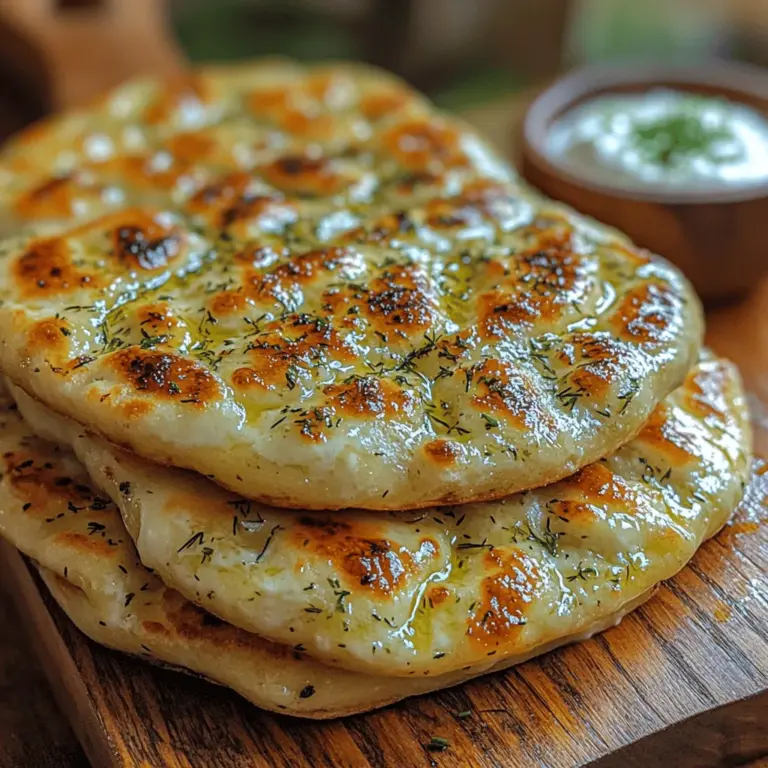Introduction to Cottage Cheese Flatbread Delight
If you’re on the lookout for a nutritious, delicious, and versatile snack or side dish, look no further than Cottage Cheese Flatbread Delight. This homemade flatbread combines simplicity with delightful flavors, making it an excellent choice for various occasions. Whether you’re enjoying it as a standalone snack, pairing it with soups, or serving it alongside your favorite dips, this flatbread is sure to impress.
Cottage cheese, the star ingredient of this recipe, is not just a creamy delight; it’s also packed with protein and essential nutrients, making it a fantastic addition to your diet. The flatbread is incredibly easy to prepare and can be customized to suit your taste preferences with various herbs and spices. In this article, we will delve into the intricacies of the Cottage Cheese Flatbread recipe, explore its nutritional benefits, and provide insights into variations and serving suggestions that will elevate your culinary experience.
Understanding the Ingredients
Exploring Cottage Cheese
Cottage cheese is a fresh cheese curd product that is low in fat and high in protein. Its creamy texture and mild flavor make it a versatile ingredient in both savory and sweet dishes. When it comes to nutritional benefits, cottage cheese is a powerhouse. A single serving is packed with protein, calcium, and various vitamins, making it an excellent choice for anyone looking to add more nutrients to their meals.
In baking and cooking, cottage cheese plays a dual role. Not only does it contribute moisture and richness to dishes, but it also acts as a binding agent, helping ingredients come together. This is particularly important in flatbreads, where a cohesive dough is vital for achieving the perfect texture. Additionally, the protein content in cottage cheese helps to create a satisfying and filling flatbread that can keep you energized throughout the day.
Essential Pantry Staples
To create the perfect Cottage Cheese Flatbread, you’ll need a few essential pantry staples that play crucial roles in the recipe:
– All-Purpose Flour: This versatile flour is the foundation of most baking recipes, including flatbreads. Its moderate protein content creates a balanced structure, making it ideal for achieving the right consistency in your dough. While all-purpose flour is recommended, you can experiment with whole wheat or gluten-free alternatives for different flavor profiles and textures.
– Baking Powder and Salt: These two ingredients may seem minor, but they are vital for the success of your flatbread. Baking powder acts as a leavening agent, helping the dough rise and creating a light, airy texture. Salt, on the other hand, enhances flavor and strengthens the dough by improving gluten formation.
– Olive Oil: This ingredient not only adds flavor but also contributes to the overall texture of the flatbread. Olive oil helps create a tender dough and adds richness, making each bite more satisfying. Furthermore, it can enhance the flatbread’s browning during cooking, resulting in a beautifully golden crust.
Flavor Enhancements
To elevate your Cottage Cheese Flatbread, consider incorporating a few flavor enhancements:
– Garlic Powder: While optional, garlic powder can add a delightful depth of flavor to your flatbread. It provides a subtle aroma and taste that pairs beautifully with the richness of the cottage cheese. Additionally, garlic powder has its health benefits, including anti-inflammatory properties and immune system support.
– Fresh Herbs: Adding fresh herbs such as parsley, chives, or dill can significantly enhance the flavor and presentation of your flatbread. Not only do they impart a burst of freshness, but they also add vibrant color, making your dish more visually appealing. Experimenting with different herbs can transform the flatbread to suit various cuisines and occasions.
Step-by-Step Guide to Making Cottage Cheese Flatbread
To prepare your Cottage Cheese Flatbread Delight, follow this detailed step-by-step guide that ensures a successful outcome.
Mixing the Dry Ingredients
The first step in creating your flatbread is to mix the dry ingredients thoroughly. Start by measuring out the all-purpose flour, baking powder, and salt. It’s crucial to use precise measurements to ensure that your flatbread turns out perfectly.
1. In a large mixing bowl, combine the all-purpose flour, baking powder, and salt.
2. Use a whisk or a fork to mix the dry ingredients. This step is essential for even distribution of the baking powder and salt throughout the flour. Uneven mixing can lead to inconsistent rising and flavor profiles in your flatbread.
Incorporating Cottage Cheese
Once your dry ingredients are well combined, it’s time to incorporate the cottage cheese. This step is vital for achieving the right consistency and moisture level in your dough.
1. Add the cottage cheese to the dry mixture. If you prefer a smoother texture, you can use a food processor to blend the cottage cheese before adding it to the dry ingredients.
2. Using a fork or your hands, gently mix the cottage cheese into the flour mixture. Be careful not to overwork the dough at this stage; you want to combine the ingredients just enough to form a shaggy dough. If the mixture feels too dry, you can add a small amount of water, one tablespoon at a time, until it reaches the desired consistency.
Kneading the Dough
Kneading is a crucial step that develops gluten, giving your flatbread its structure and chewiness.
1. Transfer the dough onto a lightly floured surface. Begin kneading the dough by folding it over itself and pressing down with your palms. Turn the dough a quarter turn and repeat this process.
2. Knead for about 5-7 minutes, or until the dough becomes smooth and elastic. If the dough is too sticky, sprinkle a little more flour as needed.
3. To check if the dough is ready, perform the “windowpane test”: pull a small piece of dough and stretch it between your fingers. If it stretches thin without tearing, it’s ready. If not, continue kneading for a few more minutes.
Adding Flavor with Oil and Herbs
Incorporating olive oil and fresh herbs can significantly enhance the flavor and texture of your flatbread.
1. Once your dough is kneaded, make a small well in the center and pour in the olive oil.
2. Fold the edges of the dough over the oil, then continue kneading to distribute the oil evenly throughout the dough. This step not only adds flavor but also helps to create a tender crumb in your flatbread.
3. If you’re using fresh herbs, now is the time to incorporate them. Gently fold in the chopped herbs until evenly distributed.
By carefully following these steps, you will create a delicious and nutritious Cottage Cheese Flatbread Delight that can be enjoyed in a multitude of ways. Stay tuned for the following sections, where we will explore cooking techniques, serving suggestions, and variations to elevate your flatbread experience further.

Choosing the Right Herbs for Optimal Flavor
To elevate the taste of your Cottage Cheese Flatbread Delight, selecting the right herbs is essential. Fresh herbs can significantly enhance the flavor profile, making each bite a delight. Here are some popular herbs that pair beautifully with cottage cheese:
1. Chives: Their mild onion flavor adds a subtle kick without overwhelming the dish.
2. Parsley: Fresh parsley can provide a refreshing contrast to the creamy texture of the flatbread.
3. Dill: This herb offers a unique flavor that complements dairy-based recipes wonderfully.
4. Oregano: A touch of oregano can infuse the flatbread with an aromatic depth, making it perfect for Mediterranean-inspired servings.
5. Basil: Sweet basil brings a fragrant, slightly peppery flavor that enhances the overall experience.
Feel free to experiment with combinations of these herbs to find your perfect blend. The addition of dried herbs is also an option; just remember that they are more concentrated, so use them sparingly.
Resting the Dough for Better Texture
Why Resting the Dough is Crucial
Resting the dough is a key step that shouldn’t be overlooked. Allowing the dough to rest helps to relax the gluten, which leads to a more tender and pliable flatbread. This means you will have an easier time rolling out the dough and achieving that desired thinness without it springing back.
What Happens to Gluten During Resting
When you mix flour with water, gluten proteins start to develop, creating a network that provides structure to the dough. However, if you roll it out immediately, the gluten remains tense, resulting in a tough flatbread. Resting gives the gluten time to relax, allowing for a softer final product. Ideally, let your dough rest for at least 30 minutes, covered with a damp cloth to prevent it from drying out.
Shaping the Flatbreads
Techniques for Rolling Out Dough Evenly
Once your dough has rested, it’s time to shape it. To roll out your flatbread evenly, follow these steps:
1. Flour Your Surface: Lightly dust your work surface and rolling pin with flour to prevent sticking.
2. Divide the Dough: Divide your rested dough into equal portions, depending on how large you want your flatbreads.
3. Flatten Gently: Start by pressing each portion with your fingers to form a small disk. This makes it easier to roll out.
4. Roll from the Center: Begin rolling from the center outward, applying even pressure. Rotate the dough frequently to maintain a round shape.
Tips to Prevent Sticking
To prevent your dough from sticking to the surface or rolling pin, keep flour handy. If the dough begins to stick, add a little more flour to your work surface or rolling pin. Alternatively, you can place parchment paper under the dough while rolling it out, which can help facilitate easy transfer to the cooking surface.
Cooking the Flatbreads Perfectly
Choosing the Right Cooking Temperature
Cooking temperature plays a crucial role in achieving the perfect flatbread. Preheat your skillet or griddle over medium-high heat. If it’s too low, the flatbreads may dry out; too high, and they may burn before cooking through. A well-heated surface ensures a nice golden-brown exterior while keeping the inside soft and fluffy.
Signs of Perfect Doneness
Keep an eye on your flatbreads while they cook. The perfect flatbread will puff up slightly, forming air pockets, and develop a beautiful golden-brown color on both sides. Generally, each side will take about 2–3 minutes to cook. You can also check by lightly pressing the surface: if it springs back, it’s done!
Serving Suggestions for Cottage Cheese Flatbread
Accompaniments and Dips
Cottage Cheese Flatbread is incredibly versatile and pairs well with various dips and spreads. Here are some recommended options:
– Hummus: A classic choice, offering a creamy texture and rich flavor.
– Tzatziki: This yogurt-based dip with cucumber and garlic complements the flatbread’s savory notes.
– Guacamole: The creaminess of avocado adds a delicious twist, making it suitable for Mexican-inspired meals.
– Pesto: A drizzle of basil pesto can elevate your flatbread with a fresh and herbaceous flavor.
Creative Ways to Serve Flatbreads
In addition to serving with dips, consider these creative serving ideas:
– Flatbread Pizza: Top your flatbread with tomato sauce, cheese, and your favorite toppings, then bake for a quick and delightful pizza.
– Wraps: Use the flatbreads to wrap around grilled vegetables, meats, or falafel for a satisfying meal.
– Mini Sandwiches: Stack layers of deli meats, cheese, and fresh vegetables for a delicious lunch option.
Using Flatbreads in Meals
Ideas for Wraps or Sandwiches
Cottage Cheese Flatbread is an excellent base for various wraps or sandwiches. Here are some ideas:
– Mediterranean Wrap: Fill with grilled chicken, cucumber, tomatoes, and a drizzle of tzatziki for a refreshing meal.
– Breakfast Wrap: Scramble eggs with spinach and feta, then wrap it up in the flatbread for a hearty breakfast.
– Falafel Sandwich: Stuff with homemade falafel, lettuce, and tahini sauce for a filling vegetarian option.
Incorporating Flatbreads into Various Cuisines
The beauty of Cottage Cheese Flatbread is its adaptability across different cuisines. Here are a few ways to incorporate it:
– Indian Style: Serve with curry or use it to scoop up lentil dishes.
– Italian Inspired: Pair with antipasto, cheeses, and cured meats for an Italian-style platter.
– Middle Eastern Feast: Include in a mezze spread with assorted dips, olives, and fresh vegetables.
Nutritional Benefits of Cottage Cheese Flatbread
Analyzing Nutritional Content
Cottage cheese is a fantastic ingredient, rich in protein while being lower in calories. A typical serving of Cottage Cheese Flatbread provides:
– Calories: Approximately 120-150 calories per flatbread.
– Protein: About 10-12 grams, thanks to the cottage cheese.
– Carbohydrates: Roughly 15-20 grams, offering energy without excessive sugar.
Health Benefits of Ingredients Used
In addition to the protein boost from cottage cheese, the flatbread also includes benefits from whole grain flour, which provides dietary fiber, aiding digestion and promoting satiety. Herbs and spices added not only enhance flavor but can also contribute additional vitamins and minerals.
Catering to Dietary Needs
Gluten-Free Variations
For those with gluten sensitivities, you can easily make a gluten-free version of this flatbread. Substitute regular flour with a gluten-free blend or almond flour to maintain the texture while ensuring it remains safe for gluten-free diets.
Vegetarian and Protein-Rich Benefits of This Recipe
Cottage Cheese Flatbread is naturally vegetarian, making it a great option for those following a plant-based diet. Additionally, the high protein content from the cottage cheese makes it a filling option, perfect for a snack or light meal. Pair it with fresh veggies or legumes to enhance its nutritional profile further.
Conclusion: Embracing the Cottage Cheese Flatbread Delight
In conclusion, Cottage Cheese Flatbread Delight is not only a simple and quick recipe but also a nutritious addition to your cooking repertoire. With its flexibility and ease of preparation, you can enjoy this delightful flatbread in numerous ways, making it a staple in your kitchen. By understanding the ingredients, mastering the cooking techniques, and experimenting with serving suggestions, you can elevate this dish to new heights. Enjoy the experience of making and sharing your own Cottage Cheese Flatbread Delight, and let your culinary imagination run wild. Whether you’re using it as a base for wraps, sandwiches, or simply enjoying it with your favorite dips, this flatbread is sure to impress family and friends alike.

